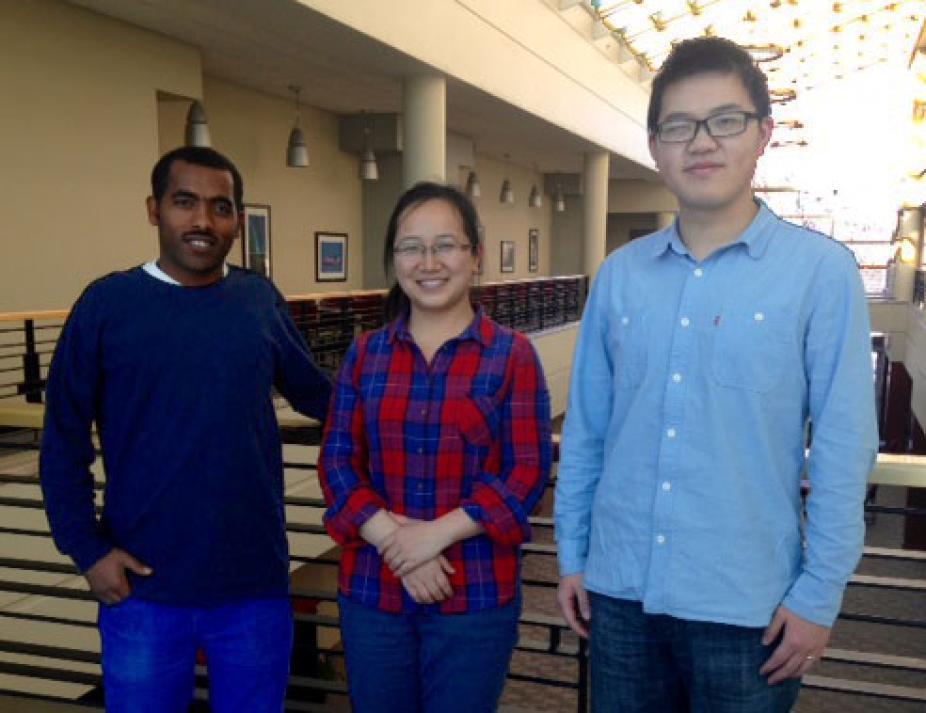Partnerships
Affiliate Scientists
Interactions between HAO and the outside community (affiliate scientists) are important for maintaining and enhancing the vibrancy of HAO's science, and an essential element of our responsibilities as part of a national center. HAO is in partnership with affiliate scientists from around the world. Affiliates generally commit to visiting for a week each year and for a longer period once every three years. Affiliates can provide the important role of channeling informal advice to the HAO Director.
Robert MacQueen Fellows
In 2020, an affiliate program was created for early-career scientists. HAO Robert MacQueen fellows collaborate with HAO staff on scientific investigations of mutual interest. The position includes access to supercomputing resources, community models, office space, and travel support. MacQueen fellows generally commit to spending one week each year at HAO.
Visitor Program

Short-term visitors at HAO come from all over the world for scientific collaboration.
The mission of the High Altitude Observatory’s (HAO) visitor program is to increase our understanding of physical systems relevant to the Sun and their effects on the Earth by promoting interactions between highly qualified researchers in a supportive, enthusiastic environment. This program invites applications for short-term visits and provides financial support for these visits. Appointments are available to undergraduate and graduate students, post-graduate researchers, and established researchers seeking sabbatical leave opportunities. These appointments include:
- Newkirk Fellowship: The application period for fellowships beginning in 2022 is January 1, 2022 - March 1, 2022.
- Postdoctoral Fellows: See the ASP website for Prospective Applicants: Advanced Study Program (ASP webpage.)
- Scientific Visitors: Applications reviewed year round.
- Summer Research Experience for Undergraduates or REU
BSA (Boulder Solar Alliance)
Boulder is lucky enough to have one of the greatest concentrations of solar physics institutions in the world. For this reason, we have formed the Boulder Solar Alliance (BSA), with representation from CU/CIRES, CU/Jila, CU/LASP, NCAR/HAO, NESDIS/NGDC, NOAA-SWPC, NSO, NWRA/CoRA, and SwRI.
Our goal is to create an environment for the Boulder Solar Physics community that creates synergy, supports innovation, and explores opportunities both locally and nationally.
COMET® (Cooperative Program for Operational Meteorology, Education and Training)
HAO sceintists are working with the COMET® program to develop an instructional web module on the "Physics of the aurora: earth systems". The COMET® Program is a world-wide leader in support of education and training for the environmental sciences, delivering scientifically relevant and instructionally progressive products and services.
Coupling, Energetics and Dynamics of Atmospheric Regions (CEDAR)
CEDAR is the dominant national and international research program in terrestrial aeronomy. Scientifically, CEDAR is devoted to the characterization and understanding of the atmosphere above ~60 km, with emphasis on the energetic and dynamic processes that determine the basic composition and structure of the atmosphere.
GONG (Global Oscillation Network Group)
GONG is a community-based program to conduct a detailed study of solar internal structure and dynamics using helioseismology. GONG has developed a six-station network of extremely sensitive, and stable velocity imagers located around the Earth to obtain nearly continuous observations of the Sun's "five-minute" oscillations, or pulsations. HAO operates the Mauna Loa Solar Observatory (MLSO) which is part of the GONG Network.
Hinode or Solar B
HINODE (Sunrise in Japanese), sometimes referred to by its pre-launch name Solar-B, is an international space observatory that carries advanced instrumentation for solar observations. Hinode was developed by the Japan Aerospace Exploration Agency in collaboration with NASA and PPARC in the UK. HAO contributed to the development of the focal plane instrumentation of the Solar Optical Telescope (with principal responsibility for the spectro-polarimeter), to the calibration of the instruments, and now to the investigation of solar magnetism. With this advanced instrumentation HINODE can perform precise, high-resolution measurements of the vector magnetic field at the solar surface and follow the evolution of magnetic structures as small as 200 km.
NSO (National Solar Observatory)
National Solar Observatory, through partnerships, conducting solar research, and educational and public outreach, aims to advance knowledge of the Sun, both as an astronomical object and as the dominant external influence on Earth, by providing forefront observational opportunities to the research community. The National Solar Observatory has one observing facility at Kitt Peak, Arizona and is currently constructing the Daniel K. Inouye Solar Telescope at Maui, Hawaii.
Whole Heliosphere and Planetary Interactions (WHPI)
WHPI is an international initiative focused around the solar minimum period that aims to understand the interconnected sun-heliospheric-planetary system. The simpler magnetic configuration and infrequency of Coronal Mass Ejections (CMEs) makes solar minimum an ideal time to follow how the solar magnetic and radiative output propagates through the heliosphere and affects the Earth and planets' atmospheres and magnetospheres. The role of WHPI is to facilitate and encourage interdisciplinary activities through a series of coordinated observing campaigns and dedicated workshops where observers and modelers get together to discuss, compare, and combine research results./p>